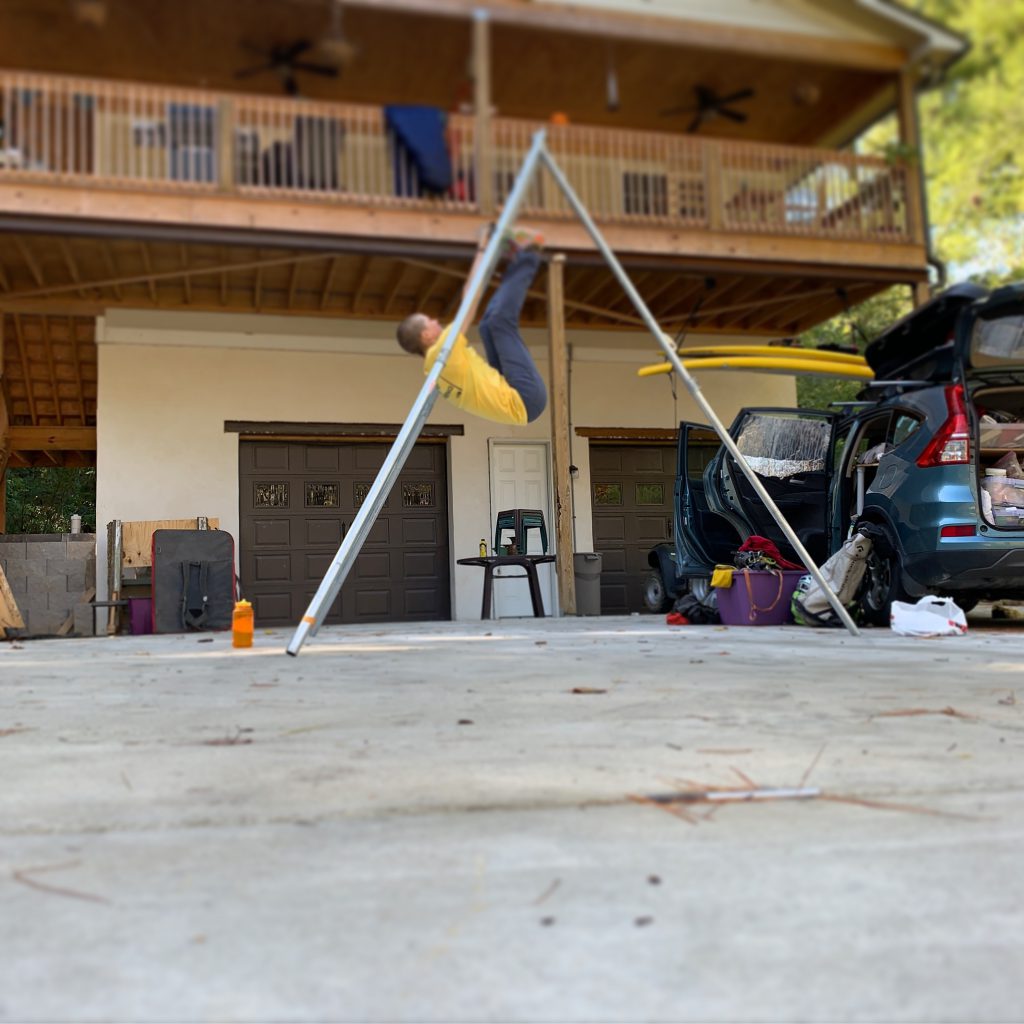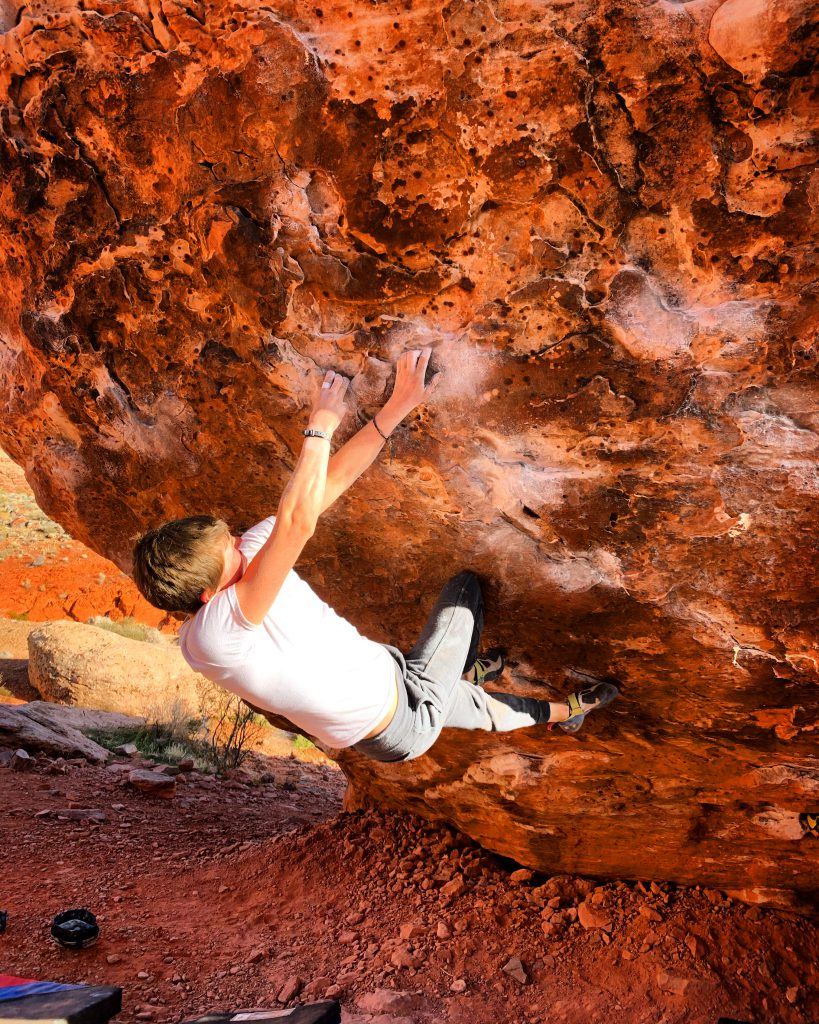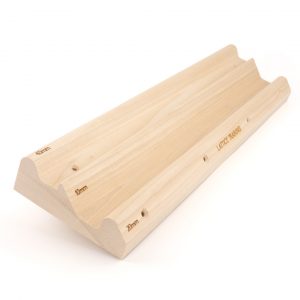For the Joy of it: Learning, Growth and Expression Through Climbing | Latticer Stories
In this Latticer Stories feature, we interview Laur Sabourin – a US-based climber and guide – about three of their recent projects; God’s Own Stone (5.14a), Welcome to Ol’ Kentuck (5.13a trad), and Great Red Roof (5.13b trad). Laur delves deeply into how they managed these projects, what drew them to them, and ultimately what they take away from having sent – or not sent – the climbs.
If you think you have your own story to tell, email [email protected].
Header Image: God’s Own Stone, 8b/8b+ by Blake McCord
Hey Laur, can you tell us a little about your recent climbing goals?
This fall, my goal was to send God’s Own Stone, a bouldery sport route in the Red River Gorge. I climbed on it last fall (2018) and was really drawn to the movement. It was a hard style for me – powerful moves on small, sloping holds. I wanted to use my time in Kentucky to build fitness for future projects and work on demystifying the grades that I wanted to climb on gear. God’s Own (8b/8b+) seemed like it would be a nice route for both of those goals.
My other goal in the Red River Gorge was Welcome to Ol’ Kentuck (7c+ trad), an overhanging big-fingers splitter. I first played around on the route in 2014, but I couldn’t do a single move on it. I love the movement and aesthetics of steep splitters, and this one is particularly gorgeous. I knew that I wanted to get back on it this year, but I was nervous to have it as my main goal because the route seeps when it rains, so it can be very weather-dependent. It was really cool to have this project because it is something that I have come back to over a long period of time, so I’ve been able to measure my long-term progress of learning this style and improving as a climber.
This winter, I wanted to climb the Great Red Roof (8a trad) in Las Vegas. It is a stunning roof crack in the Calico Hills. I climbed on it a few times over the past three years, but really took it on as a project last spring after a few inspiring sessions on it with my friend, Jessie.

Photo: Blake McCord
Sounds incredible! What inspired you to first try these routes, and when (if ever) did they seem attainable?
The first time that I tried to climb on Ol’ Kentuck, I had just climbed the hand crack to the left of it that shares an anchor. I tried to lower down and place directionals to top-rope it, but it was too steep for me at the time to pull in on ring locks. A few years later, I went out with a friend to try it and rigged a hilariously complicated double-belay system (top-rope and lead) so that we could try the moves without swinging out. That session was also not super productive. This year, another friend of mine was in town who loves crack climbing, and she offered to go out with me. This time, with more ring-lock and baggy-fingerlock experience, I felt more confident to lead it on my first go. The moves felt doable and I got super stoked to do it.
God’s Own Stone was a hard project for me to commit to. I originally chose to do it after sending a project in the area that I was working on with a friend. I wanted to keep going out to that area, and God’s Own was a reasonable next step after the project that I had finished (or so I thought). The first season that I got on it, I couldn’t do more than two moves of the crux at a time. I only tried the route one or two times a day and then just did mileage because it seemed too hard. This year, I felt much stronger in the positions, but it still took me a few days of effort to link all of the crux moves together.
I first got on the Great Red Roof when I saw a video of a climber on it. I had been climbing on a lot of routes with really tiny gear and hard to protect cruxes. I often stayed in my comfort zone by top-roping those routes and I wanted to try something at my limit that felt reasonable to work on lead. It was fun to go out to the Red Roof with different friends – I learned new beta from each of them and fused it together to make my own sequences.
The first time that I linked the beginning half of the route, I was hooked. It was most of what I talked about this year when someone asked me if I had a project.

Photo: Drew Smith
What inspires you to climb, and in particular, to try routes that challenge you?
I find a lot of joy in climbing. When I climb, I get to express myself in a really authentic way and connect with my body. I think we place a lot of emphasis on verbal expression of emotion and experience. Climbing is a beautiful, non-verbal medium for exploration.
I think there is a lot of power in working routes that challenge me. Working through the sequences has taught me how to deal with stress in a healthy way. I love finding the beta that works for me or finding just the right balance of tension and relaxation to make a big link. Projecting is a fun way to fill an inherent need for learning and growth.
There’s also an important element of self-care in projecting. When I am working on a hard route, I focus on how I am treating my body and I become more intentional about the structure of my days. I make sure that I am resting, eating properly, stretching at night, and warming up well. I plan out my week to make sure that there is time in my schedule to go out climbing.
I also love the way that climbing brings people together to work towards a goal. I’ve made some of my best friends by sharing a project. There’s an element of vulnerability that goes into working on a hard route – a lot of emotion comes up, and some of it is hard to deal with. Building trust with a climbing partner means a lot more than trusting them to catch you- it’s also about learning to communicate and support each other.

When we set goals, we open ourselves up to the possibility of either failing or succeeding. Do you do anything to manage the mental barrier that potential failure brings?
Yes. I think I have a pretty healthy perspective on success and failure, but I definitely still experience frustration and sadness when I am not achieving my goals. I think that the hardest times for me while projecting are the days when I am making “negative progress” and falling below my high point or when I make several attempts without any obvious progress.
When these things come up, I do my best to redirect my attention from frustration to learning. I ask myself what I am doing well and what I can still do to improve. By being curious, I open myself up to the experience and have more fun.
In addition, I remind myself about my reasons for climbing and talk to my partners about what I am up to. When I was climbing on God’s Own Stone, for instance, I had several conversations with my friend Blake, who I was working the route with, about what I was up to. When I wanted to be closer to sending than I was, I would remind myself that I had picked the route because it was a challenging style for me and I believed it would be good preparation for my other goals this year. I didn’t pick it because it was easy for me or because the move was high percentage. We also discussed how I wanted to do everything in my control to send the route – taking adequate rests, fueling well, and putting as much effort into every burn as possible. Being honest about how much I cared, but also reminding myself that sending wasn’t my sole reason for climbing this fall, helped me stay motivated whether I was seeing progress or experiencing a rough day.
With your recent goals – how did you feel for achieving them or leaving them behind?
It was really fun to send Welcome to Ol’ Kentuck on my second day this season. It’s a route that I’ve thought about so much over the years, so it meant a lot to me to be on it. I felt strong in the positions and enjoyed my time climbing on it a lot.
I left God’s Own Stone after a season of work and a couple of very close one-hangs. It was so hard to leave it for the season, but I had family and work obligations to take care of. On my last day, I reminded myself that I could come back to the route another season, with more climbing and training under my belt. In a way, leaving God’s Own Stone behind for the season felt really motivating. I have a route in mind that I want to get stronger for. I loved my time climbing on the route this season and wouldn’t have traded it in for anything.
Sending the Great Red Roof was just the best. It’s a short route, so wasn’t time to think about what I was doing. I was tired on my redpoint go. I had just pink-pointed it on my 3rd go, so I had already put a lot of energy into the route that day. I was nervous, but I was able to stay committed to climbing my best. Having the pink-point experience was really confidence-inspiring and I felt strong through the crux.
Sending the Red Roof made me feel motivated to try other projects that seem impossible or outside of my style. Trying those types of routes shows me what I can work on in my climbing and teaches me way more new things than trying a route that I can send easily.

How did you decide to leave God’s Own Stone behind? And do you think you will ever come back to it?
I decided to leave God’s Own Stone because I had made a commitment to take care of a family member after surgery. The week before I had to leave, when I was getting really close on the project, I wanted to find a way to stay down in Kentucky. I considered calling another family member to see if they could help for a few days so that I could extend my trip. When I reflected on what is important to me, though, I thought about how many times my family has taken care of me and how much they support me (in my climbing and in my life). Climbing is important to me, but not as important as the people that I love. I knew that if I respected my boundaries and took care of all of the aspects of my life, I would be more balanced and would end up climbing way better than if I had tunnel vision and only cared about the route.
I will definitely return to God’s Own Stone. It may have to be next year, but in the meantime, I know what I need to train for. Even though the route is on the back burner, it still provides inspiration when I am training and when I am selecting other projects to work on.
At what point did you decide to start specifically training for climbing? How do you feel from your training with Lattice?
I was on a youth climbing team, so training (in one form or another) was a part of my climbing from a young age. When I first started working as a guide, I took a few years off of training and focused on climbing outside as much as I could. I saw a lot of improvement at first, but then realized that my weaknesses were becoming more accentuated (especially my strength and power) and decided it was time to become more intentional about the way that I used my climbing time.
After a few years of following my own training plans, I decided to start training with Lattice as a gift to myself. I think it is hard to write a training plan for yourself without accidentally leaving gaps. Training with Lattice has already made my training feel more well-rounded and thoughtful.
Following the plan is a form of self-care for me. I look forward to going to the gym and doing the sessions. I’ve felt strong in my climbing and prepared for my projects.

Could you tell us a little about what you do in your day-to-day life, and how you fit your training for climbing around this?
I work as the Climbing Director for The Warrior’s Way, a mental training organization. This involves a combination of teaching clinics, working with individuals, coaching remote clients, and training new instructors for the organization. I also work as a climbing guide in the Southwest US during peak seasons. While this work keeps me busy, it also puts me in key climbing locations at the best times of the year and gives me access to gyms throughout the rest of the year. I make sure to prioritize training so that I am not squeezing it in when I am tired at the end of the day, so I often wake up early to train before work. Some days, especially when I am guiding, I have to train after a long day of physical work. On those days, I take time in between to eat a solid meal and check in with my body before starting. I always write down what I am going to do that day so that I am mentally prepared to go into the gym and work hard.
What are the best pieces of advice you would give to others with regards to training towards their goals?
I think it’s important to be clear about your goals before writing a plan. Choosing goals that feel realistic and inspiring makes it more fun to put in the work. In addition, being willing to take start small and build is really important. There have been some workouts that felt really easy the first week, but when the load or intensity increased the next week, I was glad that I had done the preparation work the week before. I make it a point to celebrate my small successes during training sessions. I find a lot of joy in celebrating what my body can do each day.

Finally, here’s what Laur’s coach, Maddy Cope, had to say about Laur as a client and athlete;
“Laur is both talented and tenacious, and it has been great working with them as they pursue a broad variety of projects! Laur was already a very experienced climber with a great ability on rock, as well as an extensive training history, so our work together has been about highlighting and working on weaknesses. This is where Laur’s motivation and mindset towards the process of becoming a better climber really comes into its own. I often work with climbers who inspire me and Laur’s attitude towards connection to climbing partners alongside the personal growth that comes with challenging ourselves, reminds me to maintain an appreciation for the challenges climbing presents irrespective of outcome.”
You can follow Laur on Instagram here, and keep checking our blog for new Latticer Stories!
Start your own Premium Training Plan with us by emailing contact@latticetraining.com.






